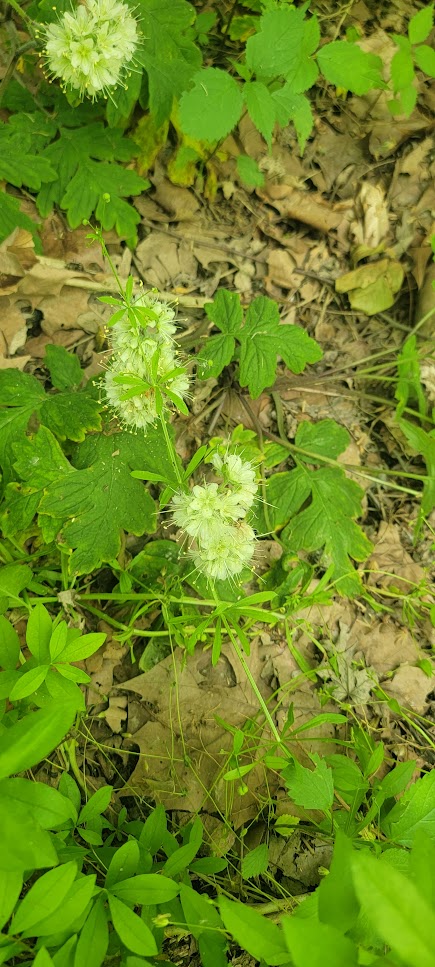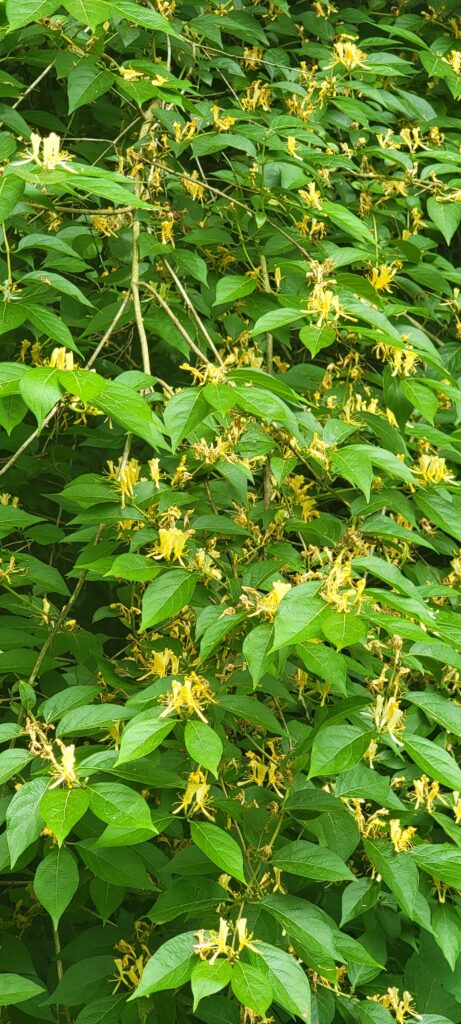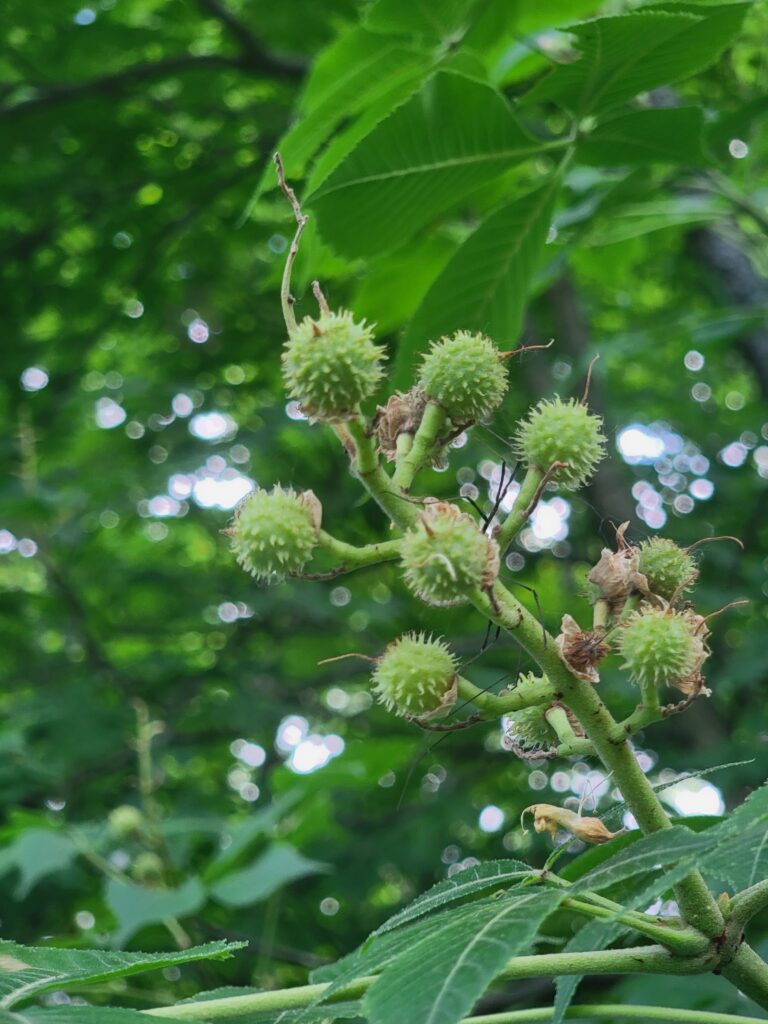Botanical Survey of Batelle Darby Creek Metro Park
Overview
Batelle Darby Creek Metro Park is a 7,000 acre park located southwest of Columbus. There are wetlands, forests, prairies, and two State and National Scenic Rivers. I chose to focus on more of the “drier” areas of the park, including areas known as Indian Ridge/Ancient Trail loop and Cedar Ridge. The forested areas consist of a tall canopy dominated by sycamores, and thick underbrush with widespread invasive honeysuckle and Japanese stiltgrass. The prairie areas mostly consist of grasses, invasive multiflora rose, and the remaining dead stalks of invasive teasels.

Overview of Columbus with the location of the park.

Map of the park.
Poison Ivy!
As the old addage goes, “leaves of three, let it be,” which is one of the easiest ways to identify poison ivy. It often grows in patches and can have either smooth or serrate margins.


Flowers!
Eastern Daisy Fleabane – Erigeron annuus
Fleabane are radially symmetric, with fused petals and modified sepals known as pappus. The gynoecium is inferior and bicarpellate, producing a single achene at maturity. This was seen at a forest-prairie transition zone. The inflorescence is a disk head with numerous individual flowers resembling a single large flower.
Common Dandelion – Taraxacum officinale
Like fleabane which are also part of the Asteraceae family, dandelions are radially symmetric, with fused petals and modified sepals known as pappus. We see these when they tranform into wish-granting flowers! The gynoecium is inferior and bicarpellate, producing a single achene/”cypselae” at maturity. This was seen in a forest environment. The inflorescence is a head with numerous individual flowers resembling a single large flower.

Dame’s Rocket – Hesperis matronalis
Dame’s Rocket is an invasive plant often confused with phlox. Part of the Brassicaceae family, these flowers are actinomorphic (radially symmetric) with 4 petals and 4 sepals that are not fused. The gynoecium is hypogenous and syncarpous. This was seen in a floodplain forest near a drainage for the trail I was on. The inflorescence is a raceme that produces siliques.

Virginia Waterleaf – Hydrophyllum virginianum
This plant is part of the Boraginaceae family. They are actinomorphic with 5 petals and 5 stamens that are not fused. The gynoecium is hypogenous and syncarpous, producing capsules on cymes. I saw this plant near the dame’s rocket, in a shaded floodplain forest understory near Big Darby Creek.

Invasive Plants (Boo!! Hissss!!!)
Autumn Olive – Elaeagnus umbellata
This invasive shrub is from eastern Asia. It can be found across the eastern United States and grows agressively in open lands. While beneficial to wildlife, it can vigorously outcompete native plants and change soil chemical compsitions. Hand pulling and herbicides are effective at removing this plant. Burning and cutting will only allow it to spread more.

The tall plant in the center. It is hard to identify by this picture but many leaves are turned in different directions giving it a “spotty/shimmery” look.
Amur Honeysuckle – Lonicera maackii
This plant originates from northerns and western China. It forms dense thickets that crowd out native plants and create monocultural areas that destroys biodiversity. It also attracts deer which can increase tick borne diseases in suburban areas. Herbicide applied to freshly-cut stumps is effective, as well as prescribed burning. Hand-pulling is only effective on small individuals.

Multiflora Rose – Rosa multiflora
Another eastern Asia native! Crowds out native species and creates dense thickets while invading open areas. Aggressive removal of the entire plant, as well as biological control through diseases such as rose rosette disease are the only known effective methods to mitigate this invasive.

Teasel – Dipsacus spp.
Native to Europe, Asia, and Africa. This genus of plants can form monocultures, crowding out native species in recently restored open lands. Herbicides are recommended for control but research into biological control by moths is being done.

Woody Plant Fruits + Plants Identifiable to Family
Ohio Buckeye – Aesculus glabra
The fruit of the buckeye is distinct. It is a spiky capsule containing a nut-like seed that resembles a buck’s eye. Ohio State’s mascot Brutus is a giant version of this! The closely related yellow buckeye has a capsule that lacks spikes.

Red Mulberry – Morus rubra
This tree has compound drupe fruits that resemble elongated blackberries. They start as catkins that form into one large fruit. Unlike the white mulberry, red mulberries grow singularly rather than in clusters.

White Clover – Trifolium repens
If you were to pick a singular “flower” off of the head of the clover, you would see it is distinctly two-lipped like members of the Fabaceae family…good news, it is part of that family!

Ground-Ivy – Glechoma hederacea
This plant can be distinguished into the Lamiaceae family due to its banner-like flowers and square stem! It also has a distinct odor reminiscent of other plants in the mint family.

The small purple flowers in the middle!
Mosses and Lichens!
Bristle Moss – Orthotrichum spp.

Baby-Tooth Moss – Mnium spp.

Speckled Greenshield Lichen – Flavoparmelia flavientor

Lemon Lichen – Candelaria concolor


